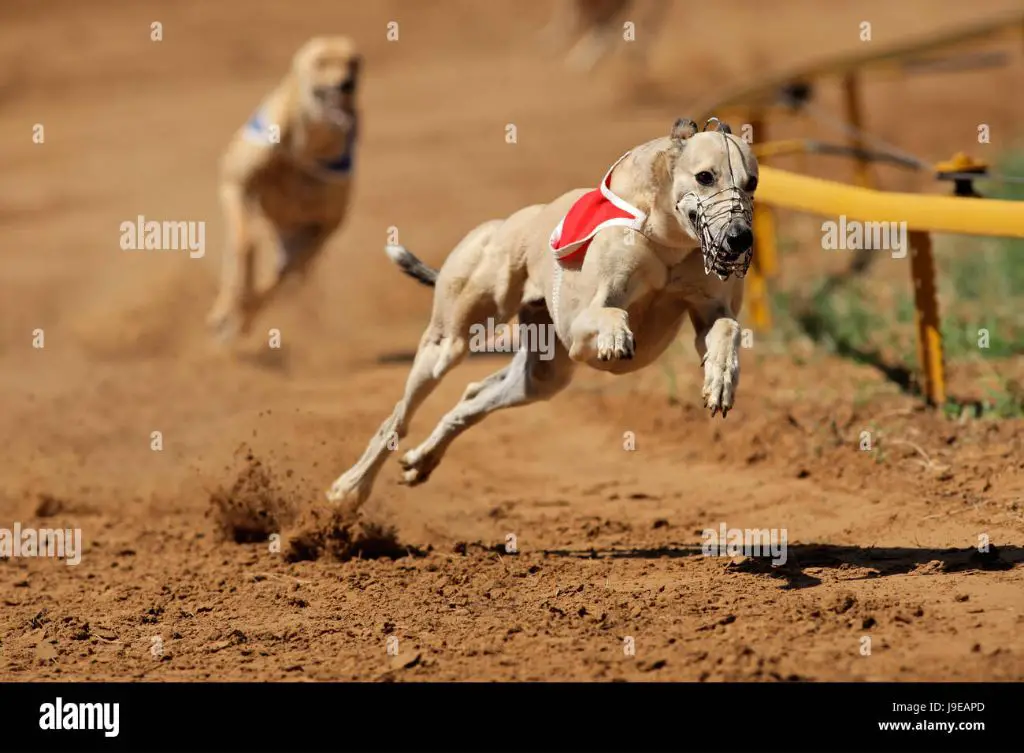Introduction
Running is a great form of exercise for dogs that provides numerous health benefits. One common question dog owners have is whether running can help build muscle in dogs. The answer is yes, running absolutely has the potential to build muscle if done correctly.
In this article, we will cover the basics of how muscle building works, look at evidence showing running does in fact build muscle, identify which muscles are targeted, discuss ideal running plans, the need for additional exercises, proper nutrition for muscle growth, and signs to look for. By the end, you will understand how to effectively incorporate running into a muscle-building regimen for your dog.
Muscle Building Basics
Muscle growth occurs when muscles are placed under stress and resistance that causes small tears in the muscle fibers. The body then repairs these microtears by fusing muscle fibers back together and adding new protein strands or filaments to the muscles. This makes the muscles larger and able to generate more force.
Weight training is considered the most effective type of exercise for building muscle because it provides targeted and progressive resistance directly to the muscles. Exercises like squats, deadlifts, bench press, and rows overload the muscles with heavier weight than they are accustomed to handling. This stimulates increased muscle protein synthesis and growth of larger muscle fibers.

While running and other cardio exercises do provide some resistance, they generally do not overload specific muscle groups enough to maximally stimulate growth. The resistance from bodyweight exercises like running is more general versus targeted at specific muscle areas. The American College of Sports Medicine recommends complementing running with weight training 2-3 times per week for optimal muscle growth.
Evidence Running Builds Muscle
While running is primarily a cardiovascular exercise, research shows it provides enough resistance to stimulate muscle growth. A study published in the European Journal of Applied Physiology found that both endurance and resistance training increased thigh muscle cross-sectional area and improved running economy in middle-distance runners. Ultrasound measurements showed a significant increase in muscle size after the 10-week training period.
Other studies using MRI scans have shown muscular adaptations in runners, such as increased thickness in gluteal and hamstring muscles. A literature review in the Scandinavian Journal of Medicine & Science in Sports concluded that running stimulates favorable structural and functional changes in skeletal muscle that likely improve performance.
Experts at the American Council on Exercise explain that the impact of running prompts muscles to adapt by becoming stronger. The constant repetition of taking strides trains muscles to contract more efficiently and powerfully. So while lifts with weights are ideal for building mass, running provides enough resistance to promote gradual muscle growth over time.
Targeted Muscles
Running targets and strengthens some of the largest muscle groups in the body, especially in the lower body. Here are the major muscles that benefit from running:
- Glutes (Butt Muscles) – Running involves powerful glute contractions with each stride to propel the body forward. Over time, this leads to increased muscle mass.
- Quadriceps – The large upper leg muscles on the front of the thigh. Running tones and defines the quads.
- Hamstrings – The muscles on the back of the thigh get a good workout during running as they contract to move the leg.
- Calves – Running works the gastrocnemius and soleus muscles of the lower leg to provide bounce and propulsion.
- Core Muscles – Running engages the abdominal muscles, obliques, lower back muscles to stabilize the body.
While the legs get the biggest muscular benefits from running, the whole body is integrated in running movements, leading to broad muscle conditioning over time.
Limitations of Running
While running can help build some muscle, it has limitations compared to targeted weight training. Running relies on using your body weight for resistance, which makes it difficult to progressively overload the muscles as they get stronger. The impact is also focused on the lower body, with less muscle activation in the upper body.
Running speed and terrain impact muscle building as well. Sprinting and running hills activates more muscle fibers than steady state running on flat ground. But sprinting is tiring and hard to maintain over long distances. Trail running and uneven terrain can help work stabilizer muscles, but also increase injury risk if not conditioned properly.
The aerobic nature of running means the body adapts in endurance-focused ways. Slow twitch muscle fibers are recruited more than fast twitch fibers that produce powerful contractions for strength and speed. So running alone rarely leads to significant muscle hypertrophy.
While better than nothing, running has limitations for optimal muscle growth compared to lifting weights, cross training, sprinting, and high intensity interval training. It takes a combination of progress overload, adequate nutrition, and recovery to maximize muscle development.
Optimal Running Plans
To maximize the muscle-building benefits of running, focus on incorporating a variety of running workouts that target different muscles and energy systems.
Speed intervals – Interval training with short sprints builds more fast-twitch muscle fibers. Try repeating sprints of 30-60 seconds, walking/jogging in between for recovery. Start with 4-6 reps and build up over time.

Hills – Running up inclines recruits more muscle fibers in the glutes, hamstrings, and calves. Aim for 8-12 hill repeats 1-2 times per week. Time the repeats or run a set distance.
Long runs – Going the distance triggers endurance-oriented slow-twitch muscle growth. Gradually increase your long run until you can comfortably run 60-120 minutes.
Recovery – Muscles grow during rest, so balance hard efforts with easy jogs and 1-2 rest days per week. Listen to your body and take time off when needed.
Periodize your training into mesocycles of 3-6 weeks building up to a peak week followed by an easier recovery week. This overload/recovery cycle maximizes adaptation.
Additional Exercise
While running is great for building leg and core muscles, it has limitations for targeting upper body muscles. To maximize overall muscle growth, it’s recommended to complement running with some weight training.
Some of the best strength training exercises to pair with running include:
- Pushups and bench presses for the chest and triceps
- Rows and pullups for the back and biceps
- Overhead presses for the shoulders
- Squats and deadlifts for the legs
Aim for 2-3 strength training sessions per week on non-running days. This gives your running muscles time to recover while building strength in the upper body. Focus on quality over quantity – lift challenging weights for 3-4 sets of 6-10 reps per exercise.
With the right balance of running and lifting, you’ll stimulate muscle growth throughout your entire body.
Nutrition for Muscle
Proper nutrition is critical for building muscle from running. While running triggers muscle growth through microtears and adaptation, your diet provides the raw materials for muscle protein synthesis. Without adequate protein and calories, your muscles won’t have the resources they need to increase in size and strength.
Protein should be emphasized in your diet to maximize muscle growth. Aim for 0.5-0.8 grams of protein per pound of body weight if trying to build muscle through running. High protein foods like chicken, fish, eggs, dairy, legumes, and protein shakes will provide amino acids that get incorporated into new muscle tissue when you recover from exercise.

You also need to consume sufficient calories to fuel muscle growth. Maintain a slight caloric surplus of 200-300 calories above your maintenance needs. The extra calories combined with exercise provides the energy surplus required for your body to increase muscle mass. Time carbohydrate intake around workouts to promote recovery and replenish glycogen stores.
Without proper protein intake and an adequate caloric surplus, your running alone won’t boost muscle growth to the same extent. Fuel your runs and recovery with a high protein, moderately high calorie diet.
Signs of Muscle Growth
There are a few key ways to monitor if your dog is building muscle from running.
Appearance – Look for increased muscle definition, particularly in the shoulders, thighs, and chest. As your dog builds muscle, you may start to see more cut lines between muscles. Their physique will start to look more toned and athletic.
Strength gains – Note if your dog is able to run faster, longer, or with less fatigue. They may also be able to jump higher and have an easier time with activities that require strength and endurance. These are signs their muscles are getting stronger from running.

Weight gain – Muscle is denser than fat, so your dog may gain some weight as they build muscle. Track their weight over time during the running regimen. Some slight weight gain along with muscle growth is normal and healthy.
Keeping an eye on these key indicators will let you know if your running routine is helping your dog build stronger, more powerful muscles over time.
Conclusion
In summary, running can stimulate muscle growth and strength gains in the lower body and core, though the effects are modest compared to targeted weight training. The key muscles strengthened by running include the glutes, quadriceps, hamstrings, calves, and core. However, running is not an efficient way to build muscle mass overall, as the upper body is mostly untouched. To maximize muscle growth, runners should incorporate targeted strength training, ensure adequate nutrition especially protein intake, allow proper rest and recovery, and be patient for gradual results over months. While running alone has limitations for muscle building compared to lifting, it offers cardiovascular benefits and can be paired with resistance training in a comprehensive fitness program. Consistency is key – the muscles must be progressively overloaded over time. With smart training and nutrition, runners can build some lean muscle while improving endurance and aerobic capacity.